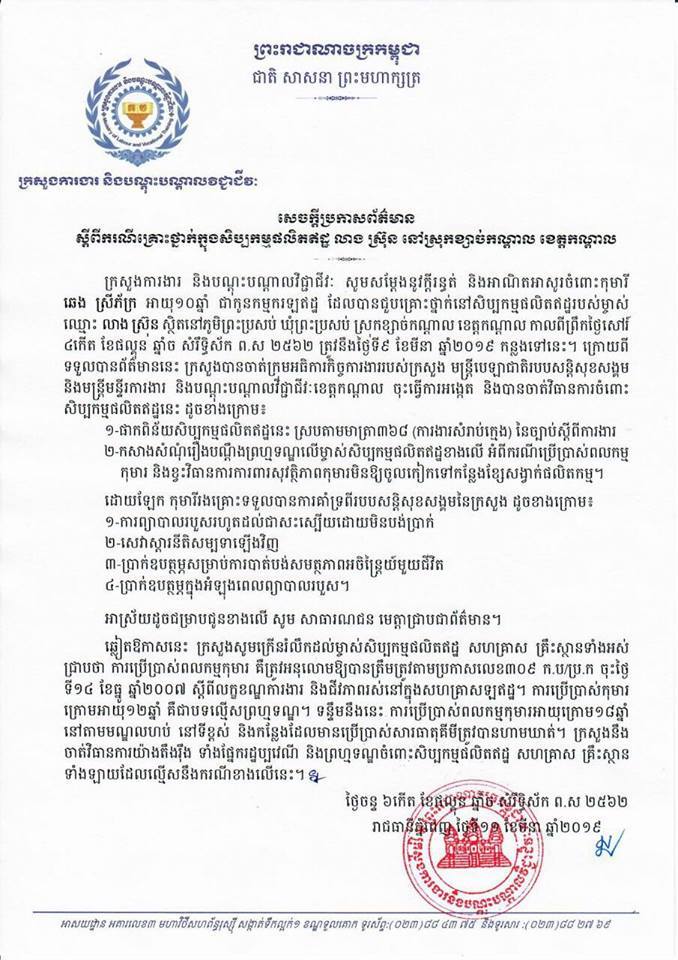The Ministry of Labor and Vocational Training has issued a notice regarding an accident in Leang Srun Brick factory in Ksach Kandal district.
The ministry will make a complaint to the owner about the use of child labor and ensure child protection measures will be taken.
Recently, a young girl lost her arm in a machine at the factory, located in Thma Puong Village, Preah Sdei Commune, Khsach Kandal District, Kandal Province. She is currently being treated by specialists in Kantha Bopha Hospital.
*From RFA below:
Cambodia’s Ministry of Labor has issued a fine and is in the process of suing the owner of a brick factory on charges of illegal child labor after a 10-year-old girl employed at the factory lost a limb while on the job.
The accident occurred on Saturday, when Chheng Srey Pheak, while working alongside her parents, slipped into a clay grinder. Her right arm was crushed to the shoulder and she is now in the hospital.
In a statement delivered Monday, the ministry said it “fined the brick factory for violating article 368 of the labor law [which deals with child labor] and filed a criminal case against the factory’s owner for using child labor and not having working safety measures in place, which allowed children to be in close proximity to processing lines.”
Article 368 fines the employer between 31 to 60 times the basic daily wage. The Phnom Penh Post reported that brick makers are paid per piece, and can expect $2-10 per day. This would make the maximum fine in this case about $600.
In the statement, the ministry identified the factory owner as Leng Srung of Kandal province.
“The ministry is appalled and takes great pity on Chheng Srey Pheak” said the ministry in the statement.
They said her hospital bills would be covered by the government’s social security funds and she would receive disability benefits for the rest of her life.
“The ministry would like to remind brick factories and other enterprises that use child labor that they must comply with the ministry’s guidelines issued in Dec. 2007. It is a criminal offense to hire children younger than 12 years old,” the statement said.
It went on to say that children under 18 were prohibited from working in environments with bad air quality, with harmful chemicals, or at extreme heights.
“The ministry will take strict measures through civil and criminal punishments against any establishment that abuses the guidelines.”
The statement by the ministry was surprising to Am Sam Ath, a senior official at the Cambodian League for the Promotion and Defense of Human Rights (LICADHO), a local NGO.
Am Sam Ath said it was rare that the ministry would take such legal action, and it should have moved sooner as LICADHO’s report on modern slavery at brick factories was released in December.
He said that the incident could have been avoided if the ministry had taken action sooner.
The LICADHO report details how desperate people take out loans from factory owners that they can never expect to pay off, but agree to work in the factories until the debt is repaid.
As workers aren’t given a salary and are paid by each brick they produce, this creates more incentive for those with families to have their children work alongside them, as they can produce more bricks in hopes of getting out of debt sooner.
But there are cases of children growing up in the brick factories while working to pay off a debt taken out by their grandparents.
The report also detailed unsanitary living conditions in the factories and severe injuries to workers, especially to children who have lost limbs to heavy machinery.
“[The accident] is a big lesson. The ministry must increase the budget for inspection of brick factories. If they find any instance of child labor, they need to act [quickly],” said Am Sam Ath.
The victim’s mother, Khim Channa, told RFA’s Khmer Service her daughter remained frightened.
“She’s awake. She is scared and the wound is still hurting. Whenever she wakes up, she cries,” she said.
RFA was unable to contact the brick factory owner for comment.
The U.S. Department of Labor’s Bureau of International Labor Affairs noted in a report for the year 2017 that Cambodia had made “moderate advancements in efforts to eliminate the worst forms of child labor.”
The report mentioned government efforts to reduce child labor but acknowledged the country had a problem in the brickmaking and sex industries.
“Inadequate resources and training also hamper the Labor Inspectorate’s capacity to enforce child labor laws, especially in rural areas and in high-risk sectors,” the report said.
Below is the notice of the Ministry of Labor and Vocational Training:

